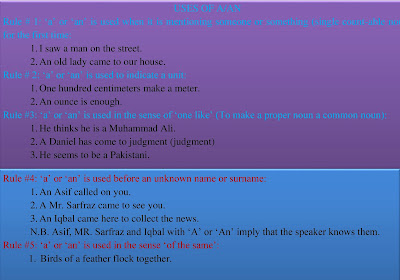LESSON PLAN OF INDEFINITE ARTICLES ‘A’ AND ‘AN’ Subject English Grade 10th
LESSON NO. 26- INDEFINITE ARTICLES ‘A’
AND ‘AN’
Subject English
Grade 10th
- The words ‘a, ‘an’ and ‘the’ are usually called Articles. They are called Articles as they have some special significance as the part of speech.
- “They are really Demonstrative Adjectives” by Wren and Martin
- But, ‘a’, ‘an’ and generalized the---to denote a class as a whole, are not Demonstrative Adjectives. Now, they are called Determiners.
- Students often make mistakes in using Articles or omitting them. They should be aware of it.
- There are two types of Articles:
- 1.
If we
wish to particularize the noun, we use the definite article:
i. Let us bath in the river. (i.e. particular river)
ii. The doctor came here. (‘The doctor’ means a particular doctor)
- 2.
If we
wish to generalize the noun, we use the indefinite article:
i. A tiger lives in a forest(i.e. any tiger or tigers and any forest or forests—in general sense)
ii. An ox is running on the road.(here an ox, that is not any particular ox, is running on a particular road)
USE OF ARTICLES
- As a general rule, a common noun in the singular number must have an article before it:
i. We can`t say, “I have seen boy”.
ii. We must say, “I have seen a boy, or the boy.”
- But a common on noun in the plural number does n`t required the definite article ‘the’ unless we wish to particularize the noun:
i. Boys (= boys generally) are fond of sweets. The boys (= those boys already refereed to, or those boys before us) are playing football.
- The choice between ‘a’ and ‘an’ is determined by sound:
- N.B.: ‘A’ will be used in place of ‘An’ when ‘h’ sounds as ‘haw’, e.g. a humble servant, a historical book etc. [humble = not ‘umble’ but ‘humble’----
USES OF A/AN
- Rule # 1: ‘a’ or ‘an’ is used when it is mentioning someone or something (single count-able noun) for the first time:
1.
I saw a
man on the street.
2.
An old
lady came to our house.
- Rule # 2: ‘a’ or ‘an’ is used to indicate a unit:
1.
One hundred
centimetres make a meter.
2.
An ounce
is enough.
- Rule #3: ‘a’ or ‘an’ is used in the sense of ‘one like’ (To make a proper noun a common noun):
1.
He thinks
he is a Muhammad Ali.
2.
A
Daniel has come to judgment (judgment)
3.
He seems
to be a Pakistani.
- Rule #4: ‘a’ or ‘an’ is used before an unknown name or surname:
1.
An Asif
called on you.
2.
A Mr.
Sarfraz came to see you.
3.
An Iqbal
came here to collect the news.
N.B. Asif, MR. Sarfraz and Iqbal with ‘A’ or ‘An’
imply that the speaker knows them.
- Rule #5: ‘a’ or ‘an’ is used in the sense ‘of the same’:
1. Birds of a feather flock together.
- Rule #6: ‘a’ or ‘an’ is used to denote profession, trade, class etc.:
1.
He is a
businessman.
2.
He is
an engineer.
3.
He is a
lawyer.
- Rule # 7: ‘a’ is used before ‘dozen’, ‘hundred’, ‘thousand’, ‘million’ etc.:
1.
Here are
a dozen of bananas.
2.
A hundred
boys came out from school.
3.
There are
a thousand people.
- Rule # 8: ‘a’ or ‘an’ is used in the sense of ‘each’ or ‘per’:
1.
He earns
one thousand rupees a month.
2.
He drives
the car at 50 km an hour.
- Rule# 9: ‘a’ or ‘an’ (also the) is used to indicate a class as a whole:
1.
A (The)
cow has horns.(i.e. All cows have horns)
2.
An
(The) elephant never forgets.
- Rule #10: ‘a’ or ‘an’ is used before some words and phrases:
1.
I have
a headache.
2.
I am in
hurry.
3.
He had
a bad cold.
4.
She had
a cough.
5. They take an interest in this.
- Rule #11: ‘a’ or ‘an’ is used in Exclamatory sentences beginning with ‘what’:
1.
What a
pity!
2.
What a
pretty girl!
3.
What a
nice bird it is!
4.
What an
awful remarks!
- Rule# 12: ‘a’ (and not the) is used before the superlative ‘most’ when it means ‘very’:
1.
He saw
a most wonderful sight. [(a most = a very) Oscar Wild!
2.
This is
a most interesting story. ( a most = a very)
- Rule #13: ‘a’ or ‘an’ is used before ‘few’, ‘little’, ‘lot of’, ‘good deal’, ‘great many’, ‘good many,, etc. and sometimes after ‘many’:
1.
Here are
a lot of books.
2.
There is
a little honey in the bottle.
3.
A great
many soldiers entered the town.
4.
I saw a
good many boys there.
5.
Many a
flower is born to blush unseen.
6.
Many an
admirer welcomed him.
7. Give me a few books.
- Note: it is also possible to say ‘few apples’,
‘little water’ but such constructions convey different meaning. They will mean ‘not
many’, ‘not much’. But really ‘a few’ and ‘a little’ mean ‘not many’ and ‘not much’.
‘Few’ and ‘little’ without article mean ‘almost nil’.
- There is a great difference between few and a few (used for countable), and between little and a little (used for uncountable). A few and a little mean ‘a small number’ and ‘a small amount’.
- Few or little, on the contrary, denote scarcity or lack.










Comments
Post a Comment